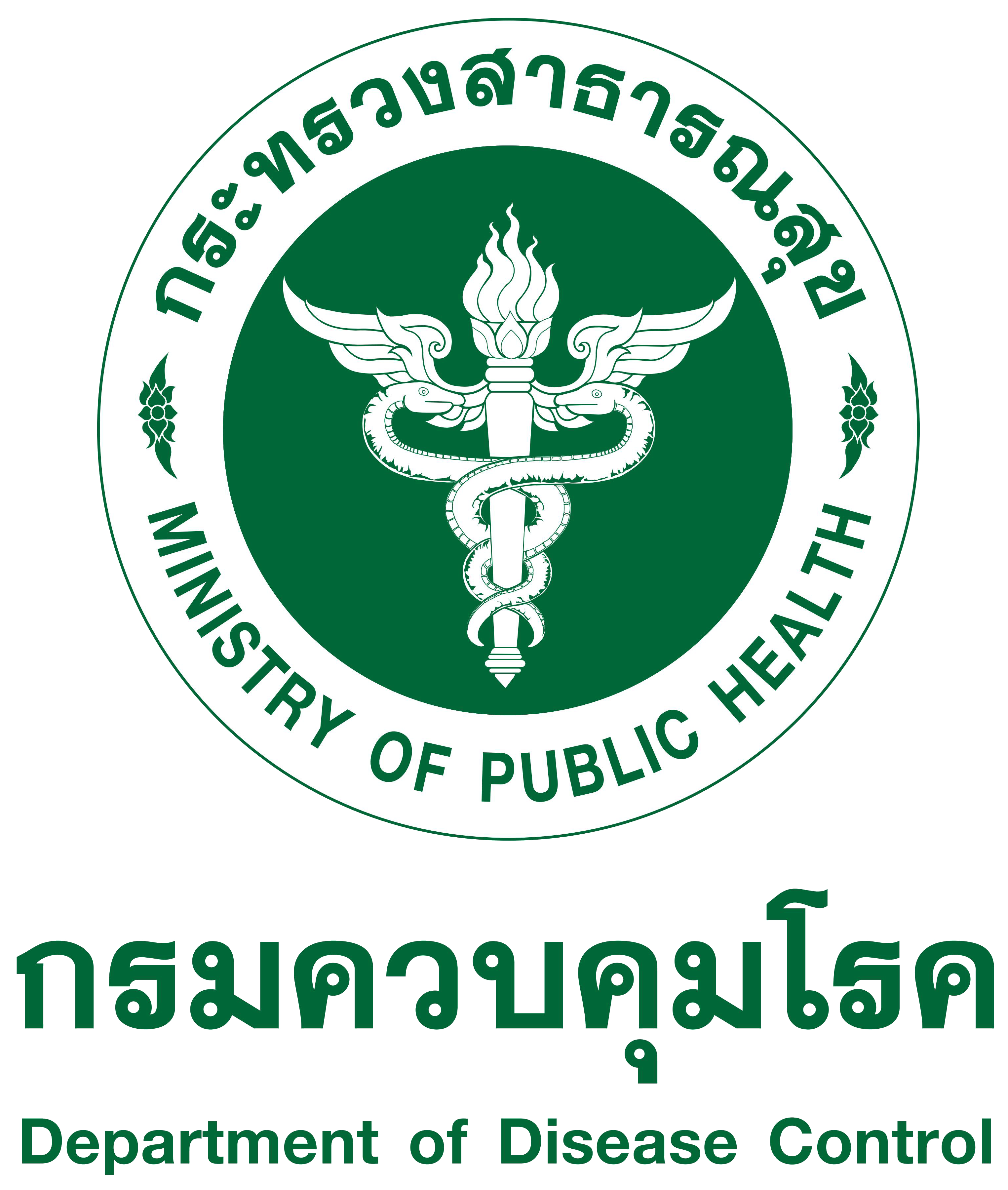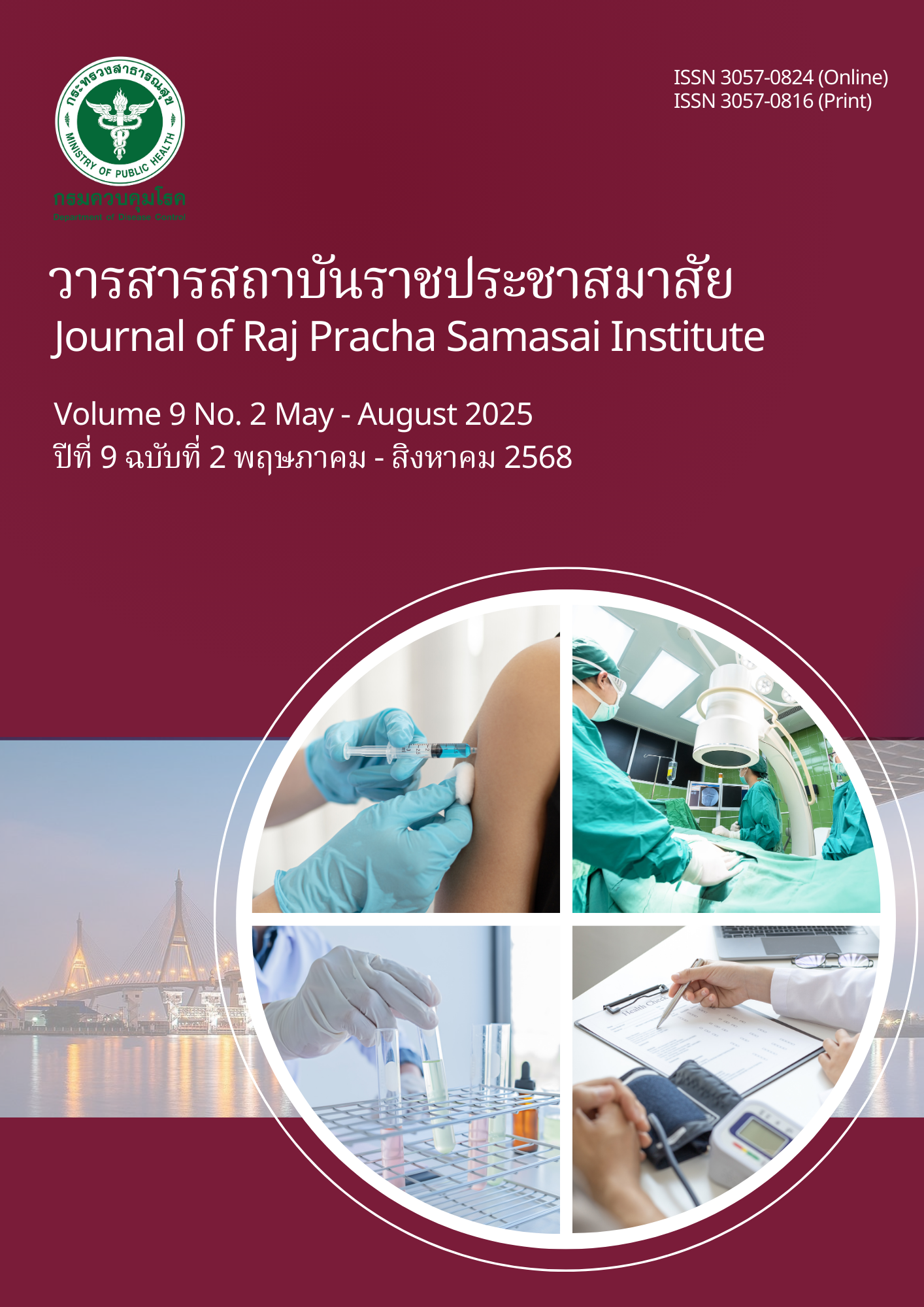A Systematic Review of Local and Global innovations for Mitigation of PM2.5 in Thailand
Main Article Content
Abstract
PM2.5 pollution has created problems of environmental and public health, including in urban and agricultural regions of Thailand. This study presents a systematic review exploring the major sources of PM2.5, its impact on human health, as well as innovations and policies. The primary sources of PM2.5 include traffic emissions, biomass burning, and industrial activities, with secondary aerosols contributing significantly to transboundary pollution. The review evaluated the effectiveness of various air purification technologies, predictive models using AI and wireless sensor networks. Despite promising technological developments, widespread implementation faces challenges such as high costs, energy demands, and limited public awareness. Strengthening policy enforcement, promoting low-cost sustainable innovations, and enhancing real-time air quality communication are essential. This review recommends that researchers, policymakers, and community workers collaborate to develop effective strategies to mitigate PM2.5 pollution and protect health of population.
Downloads
Article Details

This work is licensed under a Creative Commons Attribution-NonCommercial-NoDerivatives 4.0 International License.
ประกาศเกี่ยวกับลิขสิทธิ์
บทความที่ลงพิมพ์ในวารสารสถาบันราชประชาสมาสัย ถือว่าเป็นผลงานทางวิชาการหรือการวิจัย และวิเคราะห์ตลอดจนเป็นความเห็นส่วนตัวของผู้นิพนธ์ ไม่ใช่ความเห็นของกรมควบคุมโรค ประเทศไทย หรือกองบรรณาธิการแต่ประการใด ผู้นิพนธ์จำต้องรับผิดชอบต่อบทความของตน
นโยบายส่วนบุคคล
ชื่อและที่อยู่อีเมลที่ระบุในวารสารสถาบันราชประชาสมาสัย จะถูกใช้เพื่อวัตถุประสงค์ตามที่ระบุไว้ ในวารสารเท่านั้น และจะไม่ถูกนำไปใช้สำหรับวัตถุประสงค์อื่น หรือต่อบุคคลอื่นใด
References
Basith S, Manavalan B, Shin TH, Park CB, Lee WS, Kim J, et al. The Impact of Fine Particulate Matter 2.5 on the Cardiovascular System: A Review of the Invisible Killer. Nanomaterials [Internet]. 2022 [cited 2025 Apr 6];12(15):2656. Available from: https://www.ncbi.nlm.nih.gov/pmc/articles/PMC9370264/#B85-nanomaterials-12-02656
World Health Organization. Types of pollutants [Internet]. Ganeva. World Health Organization 2021 [cited 2025 Apr 6]. 1 p. Available from: https://www.who.int/teams/environment-climate- change-and-health/air-quality-and-health/health-impacts/types-of-pollutants
Tao J, Gao JR, Zhang L, Zhang R, Che H, Zhang ZP, et al. PM2.5 pollution in a megacity of southwest China: source apportionment and implication. Atmospheric Chemistry and Physics [Internet]. 2014 [cited 2025 Apr 6];14(16):8679–99. Available from: https://acp.copernicus.org/articles/14/8679/2014/
Sompornrattanaphan M, Thongngarm T, Ratanawatkul P, Wongsa C, Swigris JJ. The contribution of particulate matter to respiratory allergy. Asian Pacific Journal of Allergy and Immunology [Internet]. 2020 [cited 2025 Apr 6];38(1):19-28. Available from: https://pubmed.ncbi.nlm.nih.gov/32105091/
Lin CC, Chiu CC, Lee PY, Chen KJ, He CX, Hsu SK, et al. The Adverse Effects of Air Pollution on the Eye: A Review. International Journal of Environmental Research and Public Health [Internet]. 2022 [cited 2025 Apr 6];19(3):1186. Available from: https://www.mdpi.com/1660-4601/19/3/1186
Li R, Zhou R, Zhang J. Function of PM2.5 in the pathogenesis of lung cancer and chronic airway inflammatory diseases. Oncology Letters [Internet]. 2018 [cited 2025 Apr 6];15(5):7506–14. Available from: https://www.ncbi.nlm.nih.gov/pmc/articles/PMC5920433/
Department of Land Transport (TH), Transport Statistics Group Planning Division. Transport Statistics Report, Fiscal Year 2019-2023 [Internet]. Bangkok. Department of Land Transport; 2024. [cited 2025 Apr 6]. 43 p. Available from: https://web.dlt.go.th/statistics/plugins/UploadiFive/uploads/6f6897ce35cd1d6a488eab4c29a548a0b5d0973421176078322eff0d7d61b5a5.pdf (in Thai)
Chanabawornsakul W, Tuprakay S, Premanoch P, Ratcha M. A Study of Government Measures and Guidelines for Managing the Particulate Matter PM2.5 Pollution Crisis in Thailand. Journal of the Association of Researchers [Internet]. 2022 [cited 2025 Apr 6];27(3):143–61. Available from: https://so04.tci-thaijo.org/index.php/jar/article/view/259514 (in Thai)
The Standard Team. Kasetsart University confirms that the dust in Bangkok comes from burning and traffic Reducing emissions from vehicles and providing advance warnings can help mitigate the issue [Internet]. Bangkok. The Standard; 2025 [cited 2025 Apr 6]. 1 p. Available from: https://thestandard.co/ku-bangkok-air-pollution (in Thai)
Ketnak P, Suanmali W. The Study a Relationship of Vehicle Volume with Total Suspended Particulate (TSP) and Particle Matter Less Than 2.5 Microns (PM2.5), Mueang District, Kamphaeng Phet Province. Journal of Science and Technology Phetchabun Rajabhat University [Internet]. 2023 [cited 2025 Apr 6];3(1):53-9. Available from: https://so04.tci-thaijo.org/index.php/jstpcru/article/view/263788 (in Thai)
Venkataraman C, Brauer M, Tibrewal K, Sadavarte P, Ma Q, Cohen A, et al. Source influence on emission pathways and ambient PM2.5 pollution over India (2015–2050). Atmospheric Chemistry and Physics [Internet]. 2018 [cited 2025 Apr 6];18(11):8017–39. doi. 10.5194/acp-18-8017-2018
Sahoo M, Sethi N. The dynamic impact of urbanization, structural transformation, and technological innovation on ecological footprint and PM2.5: evidence from newly industrialized countries. Environment, Development and Sustainability [Internet]. 2021 [cited 2025 Apr 6];24(3):4244-4277. Available from: https://link.springer.com/article/10.1007/s10668-021-01614-7
Chansuebsri S, Kolar P, Kraisitnitikul P, Kantarawilawan N, Yabueng N, Wiriya W, et al. Chemical composition and origins of PM2.5 in Chiang Mai (Thailand) by integrated source apportionment and potential source areas. Atmospheric environment [Internet]. 2024 [cited 2025 Apr 6];327:120517. Available from: https://www.sciencedirect.com/science/article/abs/pii/S1352231024001924 (in Thai)
Phantu S, Kaenbubpha K, Ployprom N, Bootdee S. Health Risk Assessment of PM2.5 exposure in Dry season from Map Ta Phut Town Municilityin Rayong Province. Science and Technology Nakhon Sawan Rajabhat University Journal [Internet]. 2022 [cited 2025 Apr 6];14(19):64–82. Available from: https://ph02.tci-thaijo.org/index.php/JSTNSRU/article/view/244407 (in Thai)
Bottle J, White ARJ. Chapter 5 - Coal analysis : The Coal Handbook (Second Edition) [Internet]. Cambridge. Woodhead Publishing; 2023. [cited 2025 Apr 6]. 133-161 p. Available from: https://www.sciencedirect.com/science/article/abs/pii/B9780128243282000029?via%3Dihub
Park J, Kim H, Kim Y, Heo J, Kim SW, Jeon K, et al. Source apportionment of PM2.5 in Seoul, South Korea and Beijing, China using dispersion normalized PMF. Science of The Total Environment [Internet]. 2022 [cited 2025 Mar 20];833:155056. Available from: https://www.sciencedirect.com/science/article/pii/S0048969722021490
Xing F, Xu X, Hu Z, Wen X, Duan W, Pang X, et al. Characterization of PM2.5 Composition and Mixing State during Haze Events in Chengdu Using Micro-Raman Spectroscopy. Atmospheric Pollution Research [Internet]. 2025 [cited 2025 Mar 20];16(3):102411–1. Available from: https://www.sciencedirect.com/science/article/abs/pii/S1309104225000133?via%3Dihub
Department of Health (TH). The Ministry of Public Health revealed that 38 million Thais live in areas with PM2.5 dust exceeding the standard, with 15 million of them being vulnerable. [Internet]. Nonthaburi. Department of Health; 2025 [cited 2025 Mar 20] 1 p. Available from: https://anamai.moph.go.th/th/news-anamai/43930 (in Thai)
Oh SJ, Yoon D, Park JH, Lee JH. Effects of Particulate Matter on Healthy Skin: A Comparative Study between High- and Low-Particulate Matter Periods. Annals of Dermatology [Internet]. 2021 [cited 2025 Mar 20];33(3):263–70. Available from: https://pmc.ncbi.nlm.nih.gov/articles/PMC8137329/
Thuengthin W. PM2.5 in Bangkok starting in 2025 is worse than in previous years [Internet]. Bangkokbiznews; 2025 [cited 2025 Mar 20]. 1 p. Available from: https://www.bangkokbiznews.com/environment/1164841 (in Thai)
Thamphanichwong K. Economic impact of PM2.5 dust [Internet]. Bangkok. Puey Ungphakorn Institute for Economic Research; 2025 [cited 2025 Mar 20]. 1 p. Available from: https://www.pier.or.th/blog/2025/0101/ (in Thai)
Pliandee P, Jaidee N, Cheypanya R, Jaidee N, Bodeerat C. Impacts from pm2.5 dust and smoke: management guidelines. Journal of MCU Phetchaburi Review [Internet]. 2024 [cited 2025 Apr 6];7(3):434–48. Available from: https://so03.tci-thaijo.org/index.php/JPR/article/view/280083 (in Thai)
Atthawanich W. The Cost of Air Pollution to Thai Society and Countermeasures fine dust and its not-so-fine impacts on Thai households [Internet]. PIER Research Briefs. Puey Ungphakorn Institute for Economic Research; 2023 [cited 2025 Apr 6]. 1 p. Available from: https://www.pier.or.th/briefs/2023/01/ (in Thai)
The Government Public Relations Department. Thai government policy on dust PM2.5 [Internet]. Bangkok. Public Relations Department; 2025 [cited 2025 Apr 6]. 1 p. Available from: https://www.prd.go.th/th/content/category/detail/id/31/iid/356729 (in Thai)
Sakunkoo P, Sarakarn P, Soroschinda K, Deesurakul O, Tangfaikunnatam A, Keerativorasakul C. Academic Discussion "PM 2.5 Dealing and Management Approach Prevention Guidelines and PM2.5 in the Current Situation”. KKU Journal for Public Health Research [Internet]. 2020 [cited 2025 Apr 6];13(3):1-6. Available from: https://he01.tci-thaijo.org/index.php/kkujphr/article/view/245769 (in Thai)
Munee P, Ruedoobua B, Kulkeratiyut S, Khamklang S, Pongphimai P, Junurai J, et al. Factors Associated withself-protecting PM2.5 dust behaviors of people living in Klang Village Ban Klang Subdistrict Mueang Pathum Thani District Pathum Thani Province. Journal of Public Health and Innovation [Internet]. 2024 [cited 2025 Apr 6];4(3):16–24. Available from: https://he01.tci-thaijo.org/index.php/J-PHIN/article/view/274124 (in Thai)
Wiwattanapaisarn P. Knowledge, Attitude and PM2.5 Preventive Behavior among People aged 18-60 in Bangkok. Academic Journal of Community Public Health [Internet]. 2024 [cited 2025 Apr 6];10(2):161–76. Available from: https://he02.tci-thaijo.org/index.php/ajcph/article/view/266561 (in Thai)
Gasemsarakoon P, Hongsam B, Saksawat K. The use digital media to promote health. Journal of Humanities and Social Sciences [Internet]. 2020 [cited 2025 Apr 6];37(3):162–82. Available from: https://so01.tci-thaijo.org/index.php/HUSO/article/view/243513 (in Thai)
Liu Y, Ma H, Zhang N, Li Q. A systematic literature review on indoor PM2.5 concentrations and personal exposure in urban residential buildings. Heliyon [Internet]. 2022 [cited 2025 Apr 6];8(8):e10174. Available from: https://www.sciencedirect.com/science/article/pii/S2405844022014621
Cheng KC, Park HK, Tetteh AO, Zheng D, Ouellette NT, Nadeau KC, et al. Mixing and sink effects of air purifiers on indoor PM2.5 concentrations: A pilot study of eight residential homes in Fresno, California. Aerosol Science and Technology [Internet]. 2016 [cited 2025 Apr 6];50(8):835-45. Available from: https://www.tandfonline.com/doi/full/10.1080/02786826.2016.1197375
Plangklang B, Biansoongnern S, Khitmettakun T. Innovative Automatic PM2.5 Air Sterilizer and Purifier Unit with Ozone, UV, HEPA Filter and Ionizer [Internet]. Pathum Thani. Rajamangala University of Technology Thanyaburi; 2025 [cited 2025 Apr 6]. 1-64 p. Available from: http://www.repository.rmutt.ac.th/xmlui/handle/123456789/3889 (in Thai)
Research & Innovation for Sustainability Center. News RISC by MQDC introduces “Fahsai” urban air purifier tower - RISC [Internet]. Samut Prakan. RISC; 2020 [cited 2025 Apr 6]. 1 p. Available from: https://risc.in.th/news/76/RISC-by-MQDC-introduces-%22Fahsai%22-urban-air-purifier-tower (in Thai)
Magnolia Quality Development Corporation Limited. RISC by MQDC Launches “Fahsai Mini” Air-Purifying Tower [Internet]. MQDC For All Well Being; 2022 [cited 2025 Apr 6]. 1 p. Available from: https://mqdc.com/well-being/676/risc-by-mqdc-launches-fahsai-mini-air-purifying-tower
Cooper E, Milner J, Wang Y, Stamp S, Mumovic D. Modelling the impact on mortality of using portable air purifiers to reduce PM2.5 in UK homes. Atmospheric Environment [Internet]. 2022 [cited 2025 Apr 6];289:119311. Available from: https://www.sciencedirect.com/science/article/pii/S1352231022003764?via%3Dihub
Khalid B, Bai X, Wei H, Huang YL, Wu H, Cui Y. Direct Blow-Spinning of Nanofibers on a Window Screen for Highly Efficient PM2.5 Removal. Nano Letters. 2017;17(2):1140-1148. doi. 10.1021/acs.nanolett.6b04771.
Liu C, Hsu PC, Lee HW, Ye M, Zheng G, Liu N, et al. Transparent air filter for high-efficiency PM2.5 capture. Nature Communications [Internet]. 2015 [cited 2025 Apr 6];6(6205):1-9. Available from: https://www.nature.com/articles/ncomms7205
Wang SJ, Zhang XY, Su D, Wang YF, Qian CM, Zhou XR, et al. Electrospinning Ag-TiO2 Nanorod-Loaded Air Treatment Filters and Their Applications in Air Purification. Molecules [Internet]. 2020 [cited 2025 Apr 6];25(15):3369. Available from: https://www.mdpi.com/1420-3049/25/15/3369
Li T, Hua M, Wu X. A Hybrid CNN-LSTM Model for Forecasting Particulate Matter (PM2.5). IEEE Access [Internet]. 2020 [cited 2025 Apr 6];8:26933-40. Available from: https://ieeexplore.ieee.org/document/8979420
Onaiwu GE, Ayidu NJ. Advancements and innovations in pm2.5 monitoring: a comprehensive review of emerging technologies. FUDMA Journal of Sciences [Internet]. 2024 [cited 2025 Apr 6];8(3): 243-255. Available from: https://fjs.fudutsinma.edu.ng/index.php/fjs/article/view/2505


